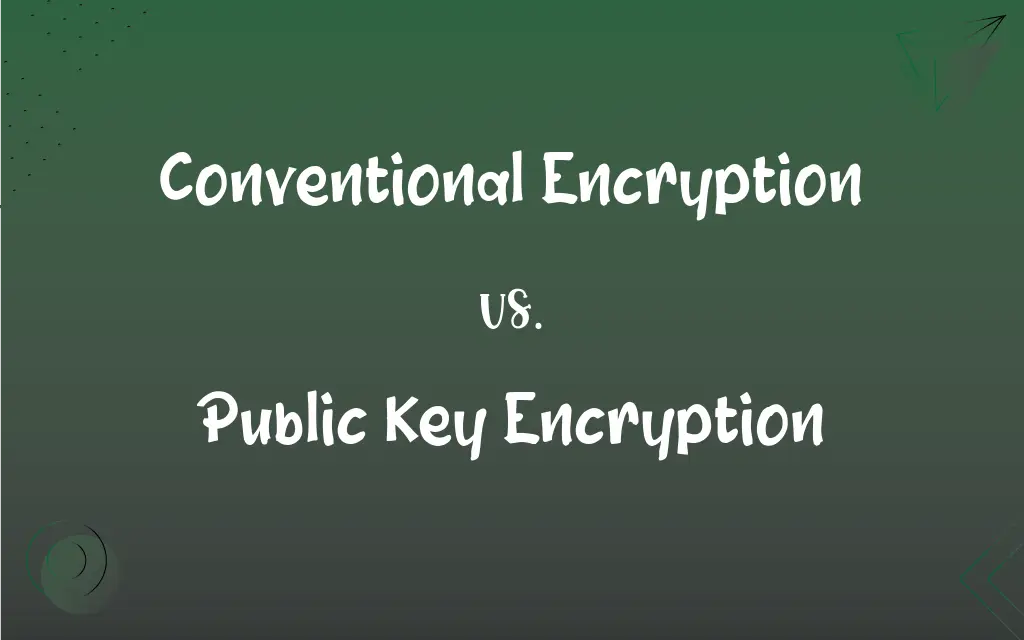Conventional Encryption vs. Public Key Encryption: What's the Difference?
Edited by Aimie Carlson || By Janet White || Published on February 29, 2024
Conventional encryption uses the same key for encryption and decryption, while public key encryption uses a pair of keys – one public, one private – for enhanced security.

Key Differences
Conventional encryption, also known as symmetric encryption, uses a single key for both encrypting and decrypting data. Public key encryption, or asymmetric encryption, employs two keys – a public key for encryption and a private key for decryption.
In conventional encryption, the same key must be securely shared among users, posing a risk if the key is intercepted. Public key encryption allows the public key to be freely distributed, while the private key remains confidential with the user.
Conventional encryption is generally faster and less resource-intensive than public key encryption. However, public key encryption provides a higher level of security, making it ideal for securing online communications.
Key management in conventional encryption can be challenging, especially in large networks, due to the need for secure key distribution. Public key encryption simplifies key management since public keys can be openly shared without compromising security.
Conventional encryption is often used for encrypting data at rest or in bulk data transfer due to its efficiency. Public key encryption is widely used in digital signatures and establishing secure communications over insecure channels, like the internet.
ADVERTISEMENT
Comparison Chart
Key Type
Single key for encryption/decryption
Two keys: one public, one private
Key Distribution
Requires secure key sharing
Public key can be openly shared
Speed and Resource Use
Faster and less resource-intensive
Slower and more resource-intensive
Security Level
Lower than public key encryption
Higher, suitable for secure communications
Common Uses
Encrypting data at rest, bulk transfer
Digital signatures, secure online communications
ADVERTISEMENT
Conventional Encryption and Public Key Encryption Definitions
Conventional Encryption
Requires secure exchange of the key between parties.
In conventional encryption, the biggest challenge was securely exchanging keys with remote offices.
Public Key Encryption
Allows secure communication over insecure channels without sharing private keys.
Public key encryption enabled them to exchange confidential information over email safely.
Conventional Encryption
Vulnerable if the shared key is intercepted or leaked.
Their conventional encryption system was compromised when an unauthorized user accessed the encryption key.
Public Key Encryption
A public key for encryption and a private key for decryption.
He used public key encryption to securely send messages over the internet.
Conventional Encryption
Commonly used in closed systems where secure key management is feasible.
Conventional encryption was ideal for their closed, internal network due to easier key management.
Public Key Encryption
Widely used for secure online transactions and digital signatures.
Online banking platforms rely on public key encryption for securing transactions.
Conventional Encryption
A type of encryption where the same key is used for both encrypting and decrypting data.
They used conventional encryption to quickly secure the company's internal communications.
Public Key Encryption
More resource-intensive, making it less suitable for encrypting large volumes of data.
Despite its security, public key encryption was not used for their large file transfers due to its slower processing time.
Conventional Encryption
Efficient and suitable for large volumes of data.
For encrypting their extensive database, they opted for the speed of conventional encryption.
Public Key Encryption
The public key can be freely distributed without compromising the private key.
Her public key was available on her website, allowing anyone to send her encrypted messages.
FAQs
How does public key encryption enhance security?
It uses two keys, keeping the private key secret while the public key is shared, providing secure communication.
Can public key encryption be used for digital signatures?
Yes, it's commonly used for digital signatures to verify the authenticity of a message.
Is public key encryption foolproof?
While highly secure, it's not completely foolproof, especially if private keys are mishandled.
What is conventional encryption?
It's an encryption method using the same key for both encrypting and decrypting data.
How is the key shared in conventional encryption?
The key must be shared through a secure channel to prevent interception.
How is key management simpler in public key encryption?
Public keys can be freely distributed without compromising security, simplifying key management.
What makes public key encryption resource-intensive?
The mathematical algorithms used for key generation and encryption processes are more complex.
How do public and private keys work in public key encryption?
The public key encrypts the data, and the corresponding private key decrypts it.
Is conventional encryption faster than public key encryption?
Yes, conventional encryption is generally faster due to simpler algorithms.
Is conventional encryption suitable for online communications?
It can be used but requires secure key distribution, which is challenging over the internet.
Can conventional encryption be hacked?
If the key is intercepted or cracked, the encryption can be compromised.
Can public key encryption be used for large data transfers?
It's possible but not ideal due to slower processing and higher resource requirements.
Can public key encryption keys be reused?
Yes, the public and private keys can be reused, but regular updates or changes are recommended for enhanced security.
What industries heavily rely on public key encryption?
Industries like banking, e-commerce, and government communications rely heavily on public key encryption for secure transactions and communications.
Are there hybrid systems combining both encryption types?
Yes, many systems use a hybrid approach, using public key encryption for secure key exchange and conventional encryption for data transfer.
How does public key encryption support confidentiality?
It ensures that only the intended recipient with the private key can decrypt the message.
What happens if a conventional encryption key is lost?
If the key is lost, the encrypted data cannot be decrypted and is essentially lost.
Is conventional encryption still relevant today?
Yes, it's still widely used, especially in scenarios where speed is crucial and secure key management is feasible.
What is a major drawback of conventional encryption?
Key distribution and management in a secure manner is a significant challenge.
Can conventional encryption be used for securing emails?
It's not typically used for emails due to the difficulty of secure key exchange.
About Author
Written by
Janet WhiteJanet White has been an esteemed writer and blogger for Difference Wiki. Holding a Master's degree in Science and Medical Journalism from the prestigious Boston University, she has consistently demonstrated her expertise and passion for her field. When she's not immersed in her work, Janet relishes her time exercising, delving into a good book, and cherishing moments with friends and family.
Edited by
Aimie CarlsonAimie Carlson, holding a master's degree in English literature, is a fervent English language enthusiast. She lends her writing talents to Difference Wiki, a prominent website that specializes in comparisons, offering readers insightful analyses that both captivate and inform.































































